Mattresses prove a top concern for many eco-friendly shoppers, particularly those worried about indoor chemicals and environmental pollution. Between flame retardants, petrochemicals and manufacturing by-products, the demand for natural and organic mattress options continues growing.
And, when you consider how much time we spend in bed, investing in an eco-friendly mattress makes sense. If you’re sleeping well, you spend about 8 hours per day or over 3,000 hours per year in bed—likely more time than you spend anywhere else in the home!
Sleep is also a time for healing and restoration, and many people are hesitant to spend this time resting on potentially hazardous chemicals. In this guide, we look at the basics of eco-friendly beds and compare the top natural mattress options so you can identify the best option for your family.
Quick View: The Best Eco-friendly Mattresses
Best Mattress to Buy Online: Amerisleep AS3
Best Memory Foam Mattress: Zoma Mattress
Best Budget Mattress: Vaya Mattress
Best Eco-Friendly Mattresses
| Mattress | Highlights | Price |
| Amerisleep AS3 | Plant-based memory foam is more breathable and responsive than traditional foam with little to no off-gassing. | $1399 |
| Avocado Green | Two layers of natural Dunlop latex plus zoned support from recycled pocket coils evenly relieves pressure point. | $1349 |
| PlushBeds Botanical Bliss | Interchangeable natural latex layers for customized comfort and support. | $2999 |
| My Green Mattress Natural Escape | Natural latex and pocketed coils relieve pressure points and evenly support body weight. | $1299 |
| Brentwood Home Cedar Luxe | Organic latex, steel pocket coils, and coconut husks provide precision pressure relief and enable better cooling through enhanced air circulation. | $1499 |
| Nest Natural Hybrid Latex | Three firmness levels for specific comfort and support levels, based on sleep position. | $1599 |
1. Amerisleep AS3
The Amerisleep AS3 mattress is 12 inches tall and contains 3 inches of Bio-Pur®, 2 inches of Affinity with HIVE® technology, and 7 inches of Bio-Core®. The soft and breathable mattress cover enables better airflow and provides a comfortable feel.
Bio-Pur® is a plant-based memory foam—manufacturers partially replace petroleum with plant oils to produce a breathable, more responsive memory foam. Bio-Pur® conforms to the body, relieving pressure points without sleepers feeling “stuck” in the mattress.
Affinity uses HIVE® technology, where hundreds of hexagonal-shaped segments form a 5-zone support system—a softer feel under the shoulders and hips and a firmer feel under the head, back, and legs. HIVE® technology evenly supports the body for enhanced pressure point relief.
Bio-Core® distributes weight across the sleep surface for even support without the risk of sagging.
The Amerisleep AS3 has a medium feel, the perfect option for side and combination sleepers, with excellent pressure point relief under the shoulders and hips.
Amerisleep includes a 100-night sleep trial and a 20-year warranty, covering sagging greater than 0.75 inches. During the first 10 years, Amerisleep will replace the mattress free of charge to the customers. During the last 10 years, Amerisleep will choose to repair or replace the mattress at a prorated charge.
Certifications: CertiPUR-US® certified
2. Avocado Green
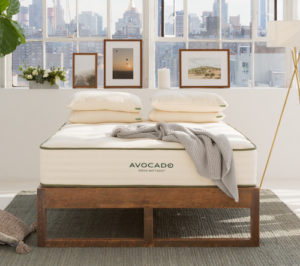
The Avocado Green mattress is 11 inches tall and contains 2 inches of Dunlop latex, 8 inches of pocketed coils, and 1 inch of Dunlop latex base foam. The hand-tufted, organic cotton mattress cover offers a soft, breathable sleep surface, and includes organic New Zealand wool batting as a natural flame retardant and wicks away moisture.
Dunlop latex is dense, durable material created from rubber tree sap. Dunlop latex provides responsive comfort by conforming to the body and relieving pressure points without sleepers sinking into the bed. Dunlop latex has little risk of overheating, an excellent option for hot sleepers.
The pocketed coils support layer is made of different gauge coils to form a 5-zone system—a softer feel for the shoulders and hips and firmer support under the head, back, and legs. Pocketed coils enhance pressure point relief and reduce motion transfer.
The 1-inch Dunlop base foam reinforces the top layers and creates a barrier between the pocketed support layer and the mattress foundation.
The Avocado mattress has a medium-firm feel, but for an extra charge, customers can add a 2-inch Dunlop latex pillow top which changes the mattress to a medium.
Avocado includes a 1-year sleep trial and a 25-year warranty, covering sagging greater than 1 inch. The first 10 years are fully covered by Avocado, but starting in year 11 and until the end of the warranty, Avocado will choose to repair or replace the mattress at a prorated charge to the customer.
Certifications: OEKO-TEX 100 Standard®, GOLS, GOTS, Greenguard Gold, eco-INSTITUT
3. PlushBeds Botanical Bliss
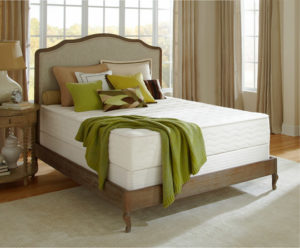
PlushBeds Botanical Bliss is 10 inches tall and contains 1 inch of New Zealand wool, 3 inches of soft Dunlop latex, 3 inches of medium-soft Dunlop latex, and 3 inches of medium Dunlop latex. The organic mattress cover enables airflow and wicks away moisture.
PlushBeds Botanical Bliss mattress is available in two firmness levels—medium and medium-firm, and in three heights—9 inches, 10 inches, and 12 inches. For this mattress review, we chose the Botanical Bliss mattress in medium at 10 inches tall.
The three Dunlop latex layers conform to the body’s natural curves to relieve pressure points with little risk of overheating for a cooler sleep. Like memory foam, Dunlop latex isolates motion, so you’re less likely to wake from movement.
The medium feel of the mattress ensures side and combination sleepers get the support they need with optimal pressure point relief in the shoulders and hips. If a medium feels too soft or too firm, all three Dunlop latex mattress layers are interchangeable, meaning sleepers can rearrange the layers for a customized feel.
Plushbeds Botanical Bliss comes with a 100-night sleep trial and a 25-year warranty, covering sagging greater than 1.5 inches.
Certifications: OEKO-TEX 100 Standard®, GOLS, GOTS, Greenguard Gold, eco-INSTITUT
4. My Green Mattress Natural Escape
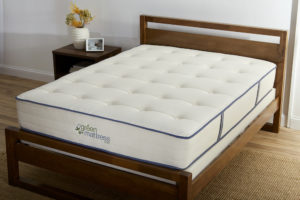
My Green Mattress Natural Escape is 11 inches tall and contains 3 inches of Dunlop latex and 8 inches of pocketed innerspring coils. The quilted organic cotton includes natural wool batting for both extra comfort and as a natural fire retardant.
Dunlop latex relieves pressure points by conforming to the body and isolates motion. Dunlop is cooler and more breathable, ensuring little risk of overheating.
Pocketed coils form a 3-zone support system with a softer feel under the head, shoulders, and legs, and a firmer feel, under the hips and back. A firm perimeter encircles the mattress for excellent edge support, so sleepers won’t have to worry about rolling off the bed.
The medium-firm feel of the Natural Escape mattress makes it a good choice for side, back, or stomach sleepers. The button tuft design secures the mattress layers without the use of adhesives.
My Green Mattress Natural Escape comes with a 120-night sleep trial and a 20-year warranty, protecting against sagging greater than 1.5 inches.
Certifications: OEKO-TEX 100 Standard®, GOLS, GOTS
5. Brentwood Home Cedar Luxe
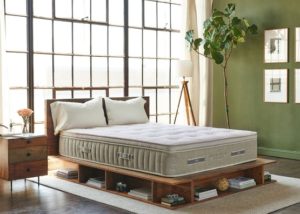
The Brentwood Home Cedar Luxe mattress is 11 inches tall and contains 1.5 inches of organic latex, 8 inches of pocketed coils, and 0.5 inches of coconut husks. The organic cotton cover includes 1 inch of soft and silky alpaca wool for extra luxury comfort.
The convoluted structure of organic latex forms around the body and provides better airflow for optimal cooling. The organic latex structure is cut by computer into 3-zone precision support with a softer feel under the head, shoulders, and legs, and firmer feel under the back and hips for enhanced lumbar support and pressure relief.
Pocketed coils form a 5-zone support system—softer for the shoulders and hips and firmer for the head, back, and legs for even pressure point relief and support plus better edge support.
The base layer contains coconut husks for better air circulation and is known for its antimicrobial properties.
The medium-soft feel of the Brentwood Home Cedar Luxe mattress cradles the hips and shoulders, making it the perfect option for side sleepers who need enhanced pressure relief in those areas of the body.
For an extra fee, customers can add a pillow top containing organic latex and wool, secured with straps and coconut buttons. Brentwood Home also includes an optional white glove delivery service for new mattress setup.
Brentwood Home includes a 1-year sleep trial and a 25-year warranty, protecting against sagging greater than 2 inches.
Certifications: OEKO-TEX 100 Standard®, Greenguard Gold, GOLS, GOTS
6. Nest Natural Hybrid Latex
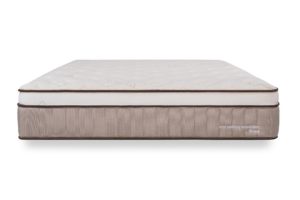
The Nest Natural Hybrid Latex is 12 inches tall and contains 3 inches of Dunlop latex, 1 inch of comfort foam, 6 inches of pocketed coils, and 1 inch of support foam. The organic knit cotton cover includes 1.5 inches of flex quilted foam and Joma wool.
Natural Dunlop latex relieves pressure points with little risk of overheating. Its responsive bounce ensures sleepers won’t feel stuck inside the mattress and find it easier to switch sleep positions at night.
Comfort foam acts as a transitional layer between the comfort and support layers, and prevents sleepers from sinking too deeply.
Pocketed coils evenly distribute weight across the sleep surface and encourage spinal alignment. While pocketed coils may have less motion isolation, they provide a responsive mattress to keep the body resting on the surface without sagging. The base support foam reinforces the bed’s shape.
The Nest Natural Hybrid Latex mattress is available in plush, medium, or firm feel, an excellent option for any sleeper, depending on their sleep preferences—side and back sleepers will enjoy the plush and medium feel for optimal pressure relief in the shoulders and hips, while back and stomach sleepers may prefer the medium and firm feel for cradling without deep sinkage.
Nest includes a 100-night sleep trial and a lifetime warranty, covering sagging greater than 1 inch and lasting only so long as the original purchaser has the mattress.
Certifications: CertiPUR-US®, OEKO-TEX 100 Standard®
What Makes a Mattress Eco-Friendly?
Eco-friendly can mean different things to different people. Generally, it means good for the environment, but it can also mean better for the environment than traditional alternatives. It can also be used facetiously.
When it comes to mattresses, an eco-friendly product would use natural materials that have less of an impact on resources or pollution than regular bedding, while also being healthier for the sleeper. Business practices also play a role.
Eco-Friendly Materials and Manufacturing
Mainstream bedding options typically consist of polyurethane foams, polyester fabric blends, conventionally-grown fibers, polyester fiber padding, and metal springs. Since many of these materials are derived from non-renewable resources, are non-biodegradable and involve pollutive manufacturing processes, they would not be considered eco-friendly by most people.
Alternatives that would make the eco-friendly cut include natural latex foam, organic cotton and wool, hemp, coconut fiber, and other animal hairs. All of these are naturally-derived, highly renewable and cause minimal impact. These natural fibers are also usually biodegradable.
Other potential materials include recycled fibers and foams, or those with partial natural materials. Some brands may use recycled foam matting above springs or incorporate recycled metals into springs (technically more eco-friendly than new foams and virgin metal).
Newer-generation polyurethane foams that replace a portion of petrochemicals with plant-based oils (often called plant-based or bio foams) also offer an alternative that is more eco-friendly than conventional foams. Some producers also go to greater lengths to reduce or negate manufacturing impact.
Limited VOC Off-Gassing and Chemicals
Off-gassing and side effects of flame retardants, adhesives, and other chemicals are a top concern for many people seeking natural or organic bed options.
Many of these chemicals of concern produce volatile organic compounds (VOCs) that can cause respiratory irritation. Some also suspect links between certain VOCs and asthma, behavior disorders, cancer risk, and other health issues. Though the most concerning VOCs have been discontinued or banned, many others remain untested for long-term safety.
All mattresses sold in the United States must withstand an open-flame test to limit the real danger of mattress fires. Manufacturers can use different methods to do this. Brominated chemicals like PBDEs, halogens like chlorinated tris, and other additives like antimony are potential methods. Fiberglass fabric barriers and dense wool are considered the more eco-friendly methods.
Adhesives are often used to hold mattress layers, fabrics and seams in place for a nicely finished product. However, these adhesives can contain many different VOC-producing ingredients. Water-based adhesives tend to be less odorous. You can also see if the adhesives pass OEKO-Tex Standard 100 or Greenguard Gold certification, both test for hazardous chemicals. Some mattresses also use no adhesives between layers, which would be the most earth-friendly option.
The other major sources of chemicals and VOCs in bedding come from traditional polyurethane foams (petro byproducts), synthetic and blended latex foams (petro byproducts), non-organic fibers (pesticide and fungicide residues), and bleaches/dyes used in manufacturing. Opting for natural latex and organically grown/processed fabrics and fibers helps minimize or eliminate these concerns.
Organic Certifications
- Global Organic Textile Standard (GOTS)
At least 70% of materials in a product are all-natural and organic.
- Global Organic Latex Standard (GOLS)
95% certified raw organic materials. Only applies to latex products.
- Greenguard Gold
Products designed for indoor use must have little to no VOCs. Greenguard Gold certified products follow stricter standards than Greenguard certification.
- CertiPUR-US®
Material created without harmful chemicals, like ozone depleters, mercury, lead, heavy metals, phthalates, and formaldehyde. Low in VOCs.
- OEKO-Tex Standard 100
Textile materials are free of harmful substances.
- Eco-Institut
No trace amounts of hazardous chemicals.
Good Business Practices
Company operations are the other factor to consider if eco-friendly purchases are important to your family. From packaging, to processing and labor, to shipping methods and even internal recycling, these secondary factors can have an impact.
Factories that recycle and reuse prevent excess waste, facilities that support fair labor promote social responsibility and conservative shipping processes help reduce fuel use and pollution.
What to Look for in an Eco-Friendly Mattress
After looking through and identifying what makes an eco-friendly mattress, consider mattress type, sleeping position, and available sleep trials, return policies, and warranties before choosing a new mattress.
Mattress Type
Each mattress type offers its own unique feel. For instance, some may want the conforming feel of memory foam, while others prefer the bounce of an innerspring.
Memory Foam
Memory foam is one of the most popular mattress types on the market due to its conforming properties—heat and pressure soften memory foam, causing it to form around the body and relieve pressure points. While not a natural material, manufacturers have taken steps to alter memory foam’s structure to be more eco-friendly.
One method is partially replacing petroleum with plant oils during the manufacturing process. Plant-based memory foam is cooler and more responsive than traditional memory foam with little to no off-gassing odor—sleepers can rest easy without feeling stuck inside the mattress.
A typical memory foam mattress contains a comfort layer of memory foam and a support layer of high-density foam. Depending on the brand, some memory foam mattresses may contain a transitional layer of poly-foam.
Innerspring
Innerspring mattresses are more commonly found in the household. Their bouncy surface makes movement easier, and the open structure of innerspring coils enables better air circulation inside the mattress. Innerspring beds tend to excel at availability and affordability, but long-term comfort and durability tend to be key issues for consumers. There are only a handful of companies producing organic innerspring beds, but they do tend to receive slightly higher ratings than standard spring beds (but are often considerably more expensive as well).
There are organic innerspring beds available, usually containing organic cotton and wool or organic/natural latex. Always check the certifications of each material if this is important to you, as sometimes only the covers will actually be certified organic.
An innerspring mattress contains a thin comfort layer of foam or fiberfill (usually as a pillow top) and a support layer of innerspring coils.
Latex
Latex has similar properties as memory foam, like body-contouring pressure relief and motion isolation, however, latex is cooler and more responsive. There are two types of latex: synthetic and natural. Synthetic latex is created through a chemical process, while natural latex is made from rubber tree sap.
Natural latex goes through one of two processes— Dunlop or Talalay. Latex made through the Dunlop method is supportive and durable but may have less softness. Talalay latex is durable, supportive, and tends to have more softness, but is more expensive. Dunlop is more natural than Talalay because Talalay contains polyurethane fillers to achieve its signature soft feel.
Generally, a latex mattress contains a comfort layer of latex and a support layer of either high-density foam or latex.
Hybrid
A hybrid mattress combines pressure-relieving memory foam and innerspring coils to form the perfect bed. While hybrids receive the benefits of both mattress types, they also get the drawbacks, including the risk of overheating and less pressure point relief. Due to the number of materials they contain, hybrids are more expensive than other mattress types and are also heavier and more difficult to move.
To be considered a true hybrid mattress, the bed must contain a comfort layer at least 2 inches thick and a coiled support layer. Many brands may claim their bed as a hybrid, but if it’s missing either or both of these features, it’s not a hybrid. Eco-friendly hybrid beds will contain either plant-based memory foam or natural latex with pocketed coils.
Generally, a hybrid mattress will contain a comfort layer of either memory foam or latex and a support layer of pocket coils.
Sleeping Position
Sleeping position can determine the right firmness level. Side sleepers, for example, need a softer surface to relieve pressure points in the shoulders and hips, while stomach sleepers need a firmer feel to keep their body supported with sagging.
Side Sleeping
Side sleeping is the most common and healthiest sleep position, enabling better breathing, improved heart health, and reduced acid reflux symptoms. For extra comfort, side sleepers can place a pillow between the knees to prevent spinal misalignment.
The best mattresses for side sleepers are soft to medium in firmness for maximum pressure point relief in the shoulders and hips.
Back Sleeping
Back sleeping naturally aligns the spine due to the back’s direct contact with the sleep surface. Some risks associated with back sleeping include snoring potential and developing sleep apnea. A pillow under the knees can improve blood circulation and reduce pressure on the lower back.
Back sleepers sleep better on a medium to a firm surface, with hip-cradling comfort and enhanced lumbar support.
Stomach Sleeping
Stomach sleeping is the least common and considered the unhealthiest sleep position. Stomach sleeping places large amounts of pressure on the spine, increasing the risk of neck strain and back pain. Placing a thin pillow under the hips reduces this pressure.
Stomach sleepers do best on a mattress with a medium-firm to firm feel, keeping their body resting on the surface without deep sinkage.
Combination Sleeping
Combination sleepers toss and turn regularly, switching between 2 to 3 sleep positions each night. Combination sleepers receive all the benefits of each sleep position, like improved heart health, and the drawbacks, including neck strain.
Combination sleepers need a medium to medium-firm mattress for consistent spinal alignment no matter the sleep position and a balance of comfort and support.
Sleep Trials, Return Policies, and Warranties
Many of the best mattress brands provide sleep trials, return policies, and warranties to reassure customers of a high-quality purchase.
Sleep Trial
A sleep trial allows customers to try out a new mattress within the comfort of their own home. Sleep trials last between 90 to 120 nights, with some trials requiring customers to keep the bed at least 30-days before accepting returns. If the customer doesn’t like the mattress, most mattress companies will issue a full refund.
Return Policy
Return policies are an okay substitute if a mattress doesn’t come with a sleep trial. Return policies typically last 30 days—about the same time it may take the body to adjust to a new sleep surface. Should the customer not like the mattress, they can return it for a refund.
Warranty
A mattress warranty generally covers any manufacturing defects which could damage the bed and sagging greater than 1 inch (varies among mattress brands). Most mattresses come with a standard 10-year warranty and only applies to the original purchaser.
FAQs
Are memory foam mattresses eco-friendly?
Plant-based memory foam mattresses are eco-friendly—plant oils partially replace petroleum during the manufacturing process, producing a memory foam more breathable and made with fewer chemicals. While there’s no such thing as “natural memory foam,” memory foam can be eco-friendly.
Is it better to sleep on a hard or soft mattress?
The firmness level you choose in a mattress depends on body weight and sleeping position. Lightweights and side sleepers sleep best on a soft to medium mattress, while back and stomach sleepers find the best comfort in medium to firm surfaces. Combination sleepers do best with a medium feel for an even balance of comfort and support.
How do I pick the best mattress?
To choose the best mattress, do your research ahead of time by reading up on different mattress types, and consider factors like body weight, sleeping position, cooling features, and budget. Also, take advantage of sleep trials to make sure a potential mattress is a right fit for you.
Conclusion
Whichever type of mattress you are considering, always make sure to do your research to avoid buyer’s remorse and surprises down the road.
Organic and healthy materials are good, but don’t get blinded – always look at the quality of the mattress layer-by-layer, and compare pricing to similar beds to determine if you are getting a good value. It’s not uncommon to see beds advertised as natural and organic mattresses that have only a tiny percentage of eco-friendly materials.
Checking reviews can be a helpful way to sort out hopeful candidates as well, and don’t forget to take a look at return and warranty policies to ensure the bed is backed by the manufacturer. Get familiar with the market, take your time, and you should be able to find a natural or organic mattress that meets your budget and comfort needs.
Have any other questions about natural or organic mattress materials? Let us know below.
This article is for informational purposes and should not replace advice from your doctor or other medical professional.
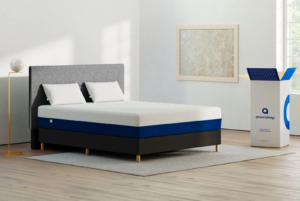
I have a queen serta perfect sleeper. This 3 months old mattress is very uncomfortable. The top part of the mattress has about a I/2 + inch depression on each side where I and my wife sleep. The center portion of the mattress is nice and firm. Is this common for the memory foam to loose its support?
I cannot sleepin memory foam and have been for four years. After several hours of sleep, usually 4 1/2 to 5 hrs, my back hurts so badly from degenerate disc and osteoarthritis I can’t move. Do you have any suggestions?